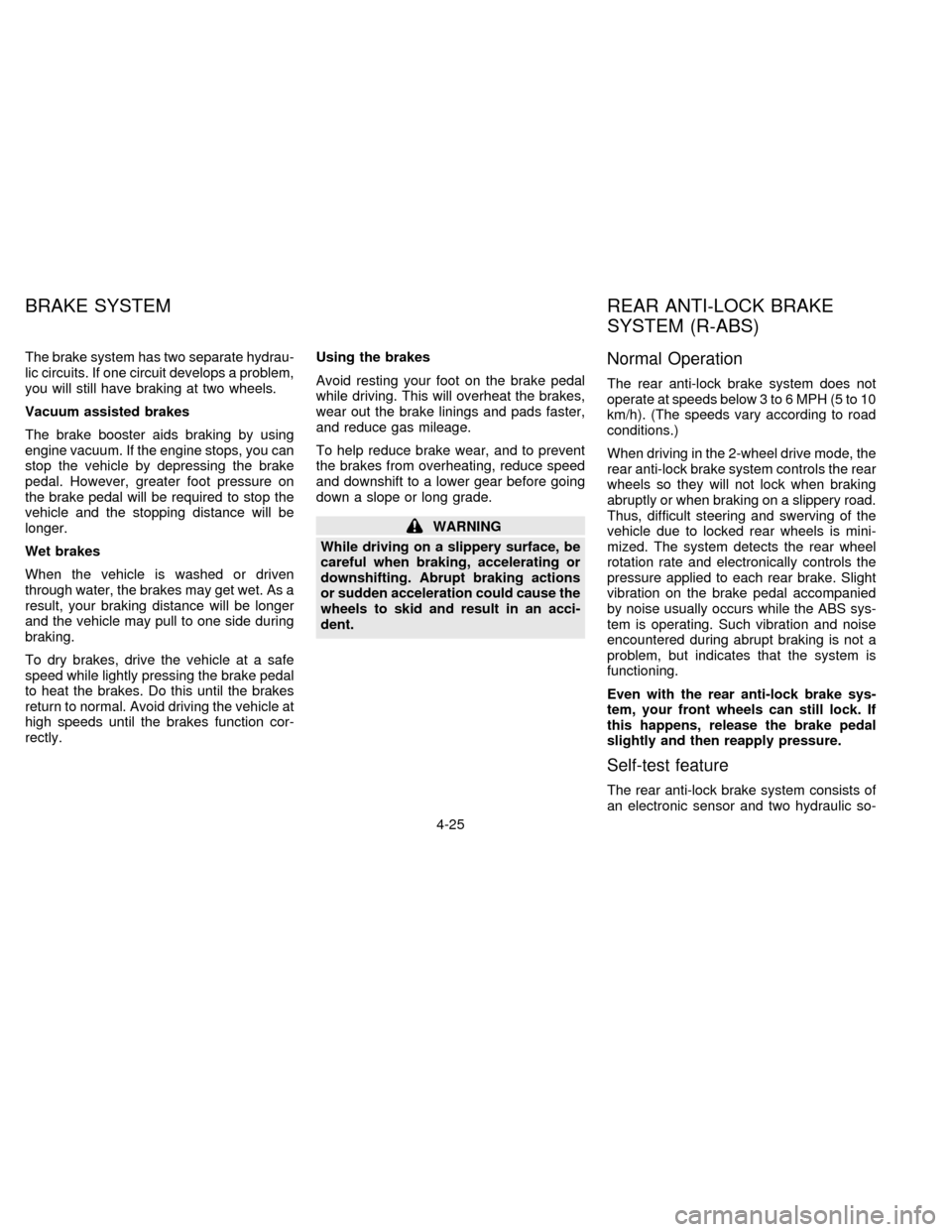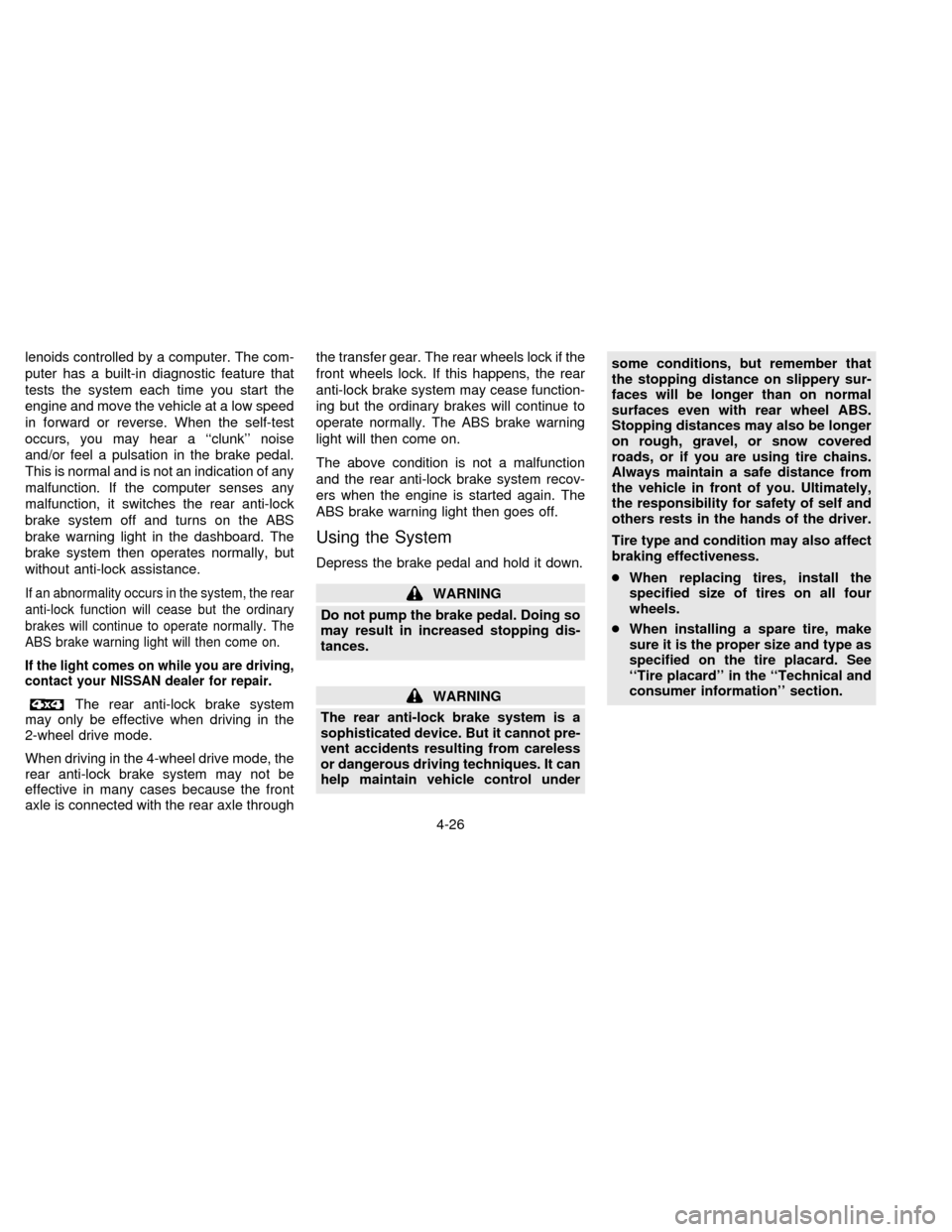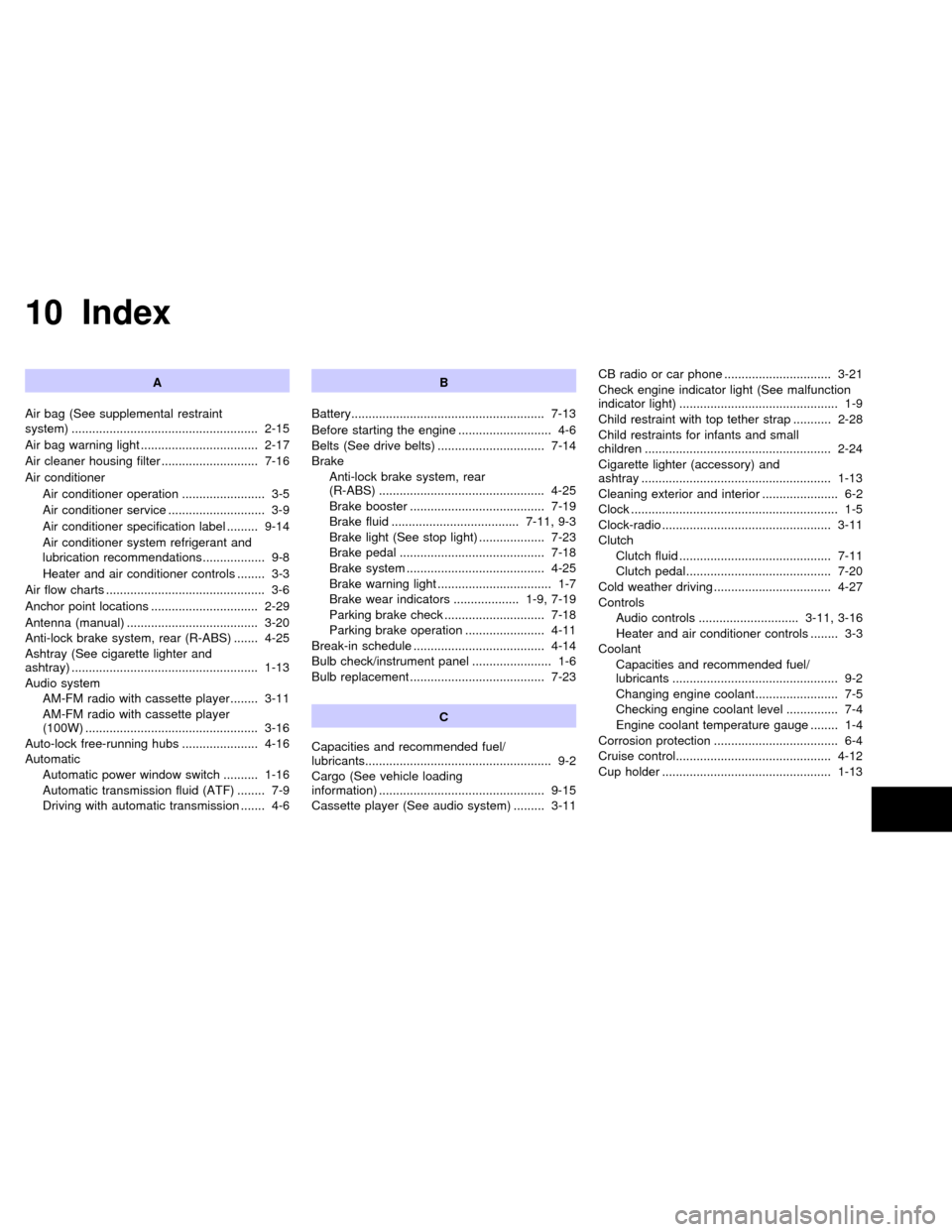1997 NISSAN FRONTIER ABS
[x] Cancel search: ABSPage 49 of 204

The retractor is designed to lock during
a sudden stop or on impact. A slow
pulling motion permits the belt to move,
and allows you some freedom of move-
ment in the seat.
3. Position the lap belt portionlow on the
hipsas shown.
4. Pull the shoulder belt portion toward the
retractor to take up extra slack.
The front passenger side seat belt has a
cinching mechanism for child seat installa-
tion. It is referred to as the automatic locking
mode.
When the cinching mechanism is activated
the seat belt cannot be extracted again until
the seat belt tongue is detached from the
buckle and the seat belt is fully retracted.
Refer to ``Child restraints for infants and
small children'' later in this section for more
information.
The automatic locking mode should be
used only for child seat installation. Dur-
ing normal seat belt use by a passenger,
the locking mode should not be acti-
vated. If it is activated it may cause
uncomfortable seat belt tension.
Unfastening the belt
To unfasten the belt, press the button on the
buckle. The seat belt automatically retracts.
Checking seat belt operation
Seat belt retractors are designed to lock belt
movement by two separate methods:
1) When the belt is pulled quickly from the
retractor.
2) When the vehicle slows down rapidly.
To increase your confidence in the belts,
check the operation as follows:
cGrasp the shoulder belt and pull quicklyforward. The retractor should lock and
restrict further belt movement.
If the retractor does not lock during this
check, or if you have any questions about
seat belt operation, see your NISSAN
dealer.
Replacing front seat belt (3-point
type only)
The front passenger seat belt is an energy
absorber type. Replace the belt when the
loop has been pulled out and ``REPLACE
BELT'' is visible. This indicator means the
seat belt has been loaded and must be
replaced.
PD1024M
2-22
ZX
Page 82 of 204

4Starting and driving
Precautions when starting and driving ...................4-2
Exhaust gas (carbon monoxide) ............................4-2
Three-way catalyst .................................................4-2
On-pavement and off-road driving precautions .....4-3
Drinking alcohol/drugs and driving .........................4-4
Ignition switch .........................................................4-4
Manual transmission ..............................................4-4
Automatic transmission ..........................................4-5
Before starting the engine ......................................4-6
Driving with automatic transmission (if so
equipped) ...............................................................4-6
Driving with manual transmission ..........................4-9
Starting the engine ...............................................4-10
Parking brake operation .......................................4-11Cruise control .......................................................4-12
Break-in schedule ................................................4-14
Increasing fuel economy ......................................4-14
Transfer case shifting procedures for 4-wheel
drive vehicles........................................................4-15
Auto-lock free-running hubs .................................4-16
Manual-lock free-running hubs.............................4-19
Driving your 4-wheel drive safely .........................4-21
Tires of 4-wheel drive...........................................4-22
Parking/parking on hills ........................................4-23
Power steering system .........................................4-24
Brake system........................................................4-25
Rear anti-lock brake system (R-ABS) ..................4-25
Cold weather driving ............................................4-27
ZX
Page 106 of 204

The brake system has two separate hydrau-
lic circuits. If one circuit develops a problem,
you will still have braking at two wheels.
Vacuum assisted brakes
The brake booster aids braking by using
engine vacuum. If the engine stops, you can
stop the vehicle by depressing the brake
pedal. However, greater foot pressure on
the brake pedal will be required to stop the
vehicle and the stopping distance will be
longer.
Wet brakes
When the vehicle is washed or driven
through water, the brakes may get wet. As a
result, your braking distance will be longer
and the vehicle may pull to one side during
braking.
To dry brakes, drive the vehicle at a safe
speed while lightly pressing the brake pedal
to heat the brakes. Do this until the brakes
return to normal. Avoid driving the vehicle at
high speeds until the brakes function cor-
rectly.Using the brakes
Avoid resting your foot on the brake pedal
while driving. This will overheat the brakes,
wear out the brake linings and pads faster,
and reduce gas mileage.
To help reduce brake wear, and to prevent
the brakes from overheating, reduce speed
and downshift to a lower gear before going
down a slope or long grade.
WARNING
While driving on a slippery surface, be
careful when braking, accelerating or
downshifting. Abrupt braking actions
or sudden acceleration could cause the
wheels to skid and result in an acci-
dent.
Normal Operation
The rear anti-lock brake system does not
operate at speeds below 3 to 6 MPH (5 to 10
km/h). (The speeds vary according to road
conditions.)
When driving in the 2-wheel drive mode, the
rear anti-lock brake system controls the rear
wheels so they will not lock when braking
abruptly or when braking on a slippery road.
Thus, difficult steering and swerving of the
vehicle due to locked rear wheels is mini-
mized. The system detects the rear wheel
rotation rate and electronically controls the
pressure applied to each rear brake. Slight
vibration on the brake pedal accompanied
by noise usually occurs while the ABS sys-
tem is operating. Such vibration and noise
encountered during abrupt braking is not a
problem, but indicates that the system is
functioning.
Even with the rear anti-lock brake sys-
tem, your front wheels can still lock. If
this happens, release the brake pedal
slightly and then reapply pressure.
Self-test feature
The rear anti-lock brake system consists of
an electronic sensor and two hydraulic so-
BRAKE SYSTEM REAR ANTI-LOCK BRAKE
SYSTEM (R-ABS)
4-25
ZX
Page 107 of 204

lenoids controlled by a computer. The com-
puter has a built-in diagnostic feature that
tests the system each time you start the
engine and move the vehicle at a low speed
in forward or reverse. When the self-test
occurs, you may hear a ``clunk'' noise
and/or feel a pulsation in the brake pedal.
This is normal and is not an indication of any
malfunction. If the computer senses any
malfunction, it switches the rear anti-lock
brake system off and turns on the ABS
brake warning light in the dashboard. The
brake system then operates normally, but
without anti-lock assistance.
If an abnormality occurs in the system, the rear
anti-lock function will cease but the ordinary
brakes will continue to operate normally. The
ABS brake warning light will then come on.
If the light comes on while you are driving,
contact your NISSAN dealer for repair.
The rear anti-lock brake system
may only be effective when driving in the
2-wheel drive mode.
When driving in the 4-wheel drive mode, the
rear anti-lock brake system may not be
effective in many cases because the front
axle is connected with the rear axle throughthe transfer gear. The rear wheels lock if the
front wheels lock. If this happens, the rear
anti-lock brake system may cease function-
ing but the ordinary brakes will continue to
operate normally. The ABS brake warning
light will then come on.
The above condition is not a malfunction
and the rear anti-lock brake system recov-
ers when the engine is started again. The
ABS brake warning light then goes off.
Using the System
Depress the brake pedal and hold it down.
WARNING
Do not pump the brake pedal. Doing so
may result in increased stopping dis-
tances.
WARNING
The rear anti-lock brake system is a
sophisticated device. But it cannot pre-
vent accidents resulting from careless
or dangerous driving techniques. It can
help maintain vehicle control undersome conditions, but remember that
the stopping distance on slippery sur-
faces will be longer than on normal
surfaces even with rear wheel ABS.
Stopping distances may also be longer
on rough, gravel, or snow covered
roads, or if you are using tire chains.
Always maintain a safe distance from
the vehicle in front of you. Ultimately,
the responsibility for safety of self and
others rests in the hands of the driver.
Tire type and condition may also affect
braking effectiveness.
cWhen replacing tires, install the
specified size of tires on all four
wheels.
cWhen installing a spare tire, make
sure it is the proper size and type as
specified on the tire placard. See
``Tire placard'' in the ``Technical and
consumer information'' section.
4-26
ZX
Page 198 of 204

10 Index
A
Air bag (See supplemental restraint
system) ...................................................... 2-15
Air bag warning light .................................. 2-17
Air cleaner housing filter ............................ 7-16
Air conditioner
Air conditioner operation ........................ 3-5
Air conditioner service ............................ 3-9
Air conditioner specification label ......... 9-14
Air conditioner system refrigerant and
lubrication recommendations.................. 9-8
Heater and air conditioner controls ........ 3-3
Air flow charts .............................................. 3-6
Anchor point locations ............................... 2-29
Antenna (manual) ...................................... 3-20
Anti-lock brake system, rear (R-ABS) ....... 4-25
Ashtray (See cigarette lighter and
ashtray) ...................................................... 1-13
Audio system
AM-FM radio with cassette player ........ 3-11
AM-FM radio with cassette player
(100W) .................................................. 3-16
Auto-lock free-running hubs ...................... 4-16
Automatic
Automatic power window switch .......... 1-16
Automatic transmission fluid (ATF) ........ 7-9
Driving with automatic transmission ....... 4-6B
Battery........................................................ 7-13
Before starting the engine ........................... 4-6
Belts (See drive belts) ............................... 7-14
Brake
Anti-lock brake system, rear
(R-ABS) ................................................ 4-25
Brake booster ....................................... 7-19
Brake fluid ..................................... 7-11, 9-3
Brake light (See stop light) ................... 7-23
Brake pedal .......................................... 7-18
Brake system ........................................ 4-25
Brake warning light ................................. 1-7
Brake wear indicators ................... 1-9, 7-19
Parking brake check ............................. 7-18
Parking brake operation ....................... 4-11
Break-in schedule ...................................... 4-14
Bulb check/instrument panel ....................... 1-6
Bulb replacement ....................................... 7-23
C
Capacities and recommended fuel/
lubricants...................................................... 9-2
Cargo (See vehicle loading
information) ................................................ 9-15
Cassette player (See audio system) ......... 3-11CB radio or car phone ............................... 3-21
Check engine indicator light (See malfunction
indicator light) .............................................. 1-9
Child restraint with top tether strap ........... 2-28
Child restraints for infants and small
children ...................................................... 2-24
Cigarette lighter (accessory) and
ashtray ....................................................... 1-13
Cleaning exterior and interior ...................... 6-2
Clock ............................................................ 1-5
Clock-radio ................................................. 3-11
Clutch
Clutch fluid ............................................ 7-11
Clutch pedal.......................................... 7-20
Cold weather driving .................................. 4-27
Controls
Audio controls ............................. 3-11, 3-16
Heater and air conditioner controls ........ 3-3
Coolant
Capacities and recommended fuel/
lubricants ................................................ 9-2
Changing engine coolant........................ 7-5
Checking engine coolant level ............... 7-4
Engine coolant temperature gauge ........ 1-4
Corrosion protection .................................... 6-4
Cruise control............................................. 4-12
Cup holder ................................................. 1-13
ZX